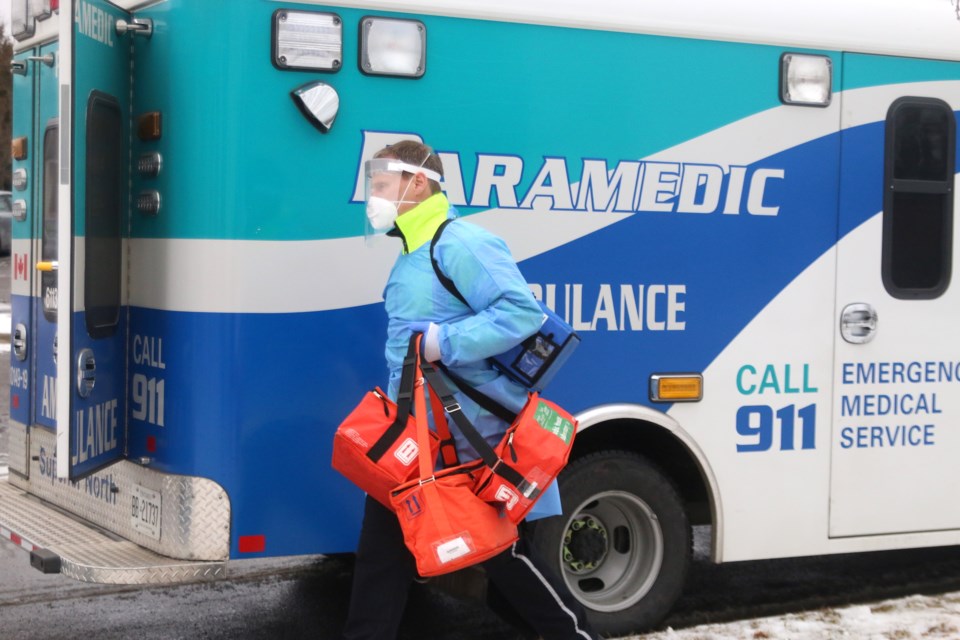THUNDER BAY – Paramedic services in the Thunder Bay District need to implement “transformational” changes to confront the approaching “tsunami” of an aging population, city council heard Monday.
Superior North EMS (SNEMS) will need to expand services in Thunder Bay to keep up with growing demand, despite stagnant population growth, consultants warned as they presented a draft 10-year plan for the agency.
Plans to consolidate services elsewhere in the district prompted concerns from two North Shore communities, meanwhile – though report authors Performance Concepts Consulting (PCC) maintained residents would actually benefit from the changes.
SNEMS faces unique challenges serving both Thunder Bay and more than a dozen smaller communities distributed over more than 100,000 square kilometres, PCC president Todd MacDonald told councillors.
“Superior North EMS is a genuinely unique Ontario paramedic service,” he said. “The combination of a busy urban centre plus a rural remote district of the scope of yours – it really is unprecedented.”
Taken together, an aging population and a growing willingness to call 9-1-1 could see annual calls for service increase by more than 150 per cent by 2030, the report projected, jumping from under 40,000 to nearly 65,000.
“It’s not exactly clear what the factors are behind this, but what we know is we’re seeing an increase in willingness to call 9-1-1,” Macdonald said. “The stoic days of people driving themselves to the hospital injured are over.”
The number of requests for service per capita is growing at around five per cent a year in the district, he said.
Without action to rein in that growing demand, SNEMS would be unable to keep up, MacDonald warned. That could lead to more “code zero” occurrences, when there are no ambulances left to respond in an emergency.
Following the plan’s recommendations, however, SNEMS could reduce the number of trips to hospital by up to 30 per cent, PCC estimated.
That would come partly by offloading responsibility for less urgent code 1 and 2 patient transfers in the district to the North West LHIN. That practice is already in place in Thunder Bay itself.
That would still require the addition of two 12-hour ambulance shifts in Thunder Bay, but would keep demand manageable, PCC estimated.
The plan would also create two consolidated stations, in Terrace Bay/Schreiber and Nipigon/Red Rock. Each of those North Shore communities currently has its own station.
It would also close a station in Beardmore, which it said is not busy enough to warrant the current 12-hour ambulance service stationed there.
The station’s “system busyness” – describing the amount of time resources are actively deployed – is around three percent. In Thunder Bay, busyness is in the mid-thirties, and was more than 50 per cent as recently as 2015.
“What we’re seeing is the Beardmore base does a very limited amount of work,” MacDonald said.
The station responds to fewer than 80 of the most serious Code 4 calls a year, the report found – roughly one every 4.7 shifts.
Most of the station’s annual $800,000 budget could be reallocated, while leaving behind a paramedic who would be on duty when the Beardmore community health centre is closed, the report advises.
However, the move to consolidate drew concerns from the mayors of Terrace Bay and Schreiber, who each sent identical letters expressing dissatisfaction with a virtual briefing held in September.
“As much as the invitation and briefing were appreciated, many of us were left with the impression that consultation with potentially affected stakeholders, was more of an afterthought than intention of the exercise,” the letters read.
Councillors Rebecca Johnson and Brian McKinnon sought assurances from PCC and the city that those concerns would be addressed before a finalized version is considered in the new year.
The report also found systemic shortcomings in SNEMS’ district stations.
“While currently ‘functional,’ there is no district station that meets all the regulatory/functional requirements for a sustainable paramedic service in Ontario,” it reads.
Only three stations approach full compliance, while four – in Shuniah, Schreiber, Beardmore, and Conmee – will need to be replaced entirely in the next five years.
SNEMS should also seek increased contributions from the provincial and federal governments in recognition of its role providing services to First Nations, the consultants recommended.
Senior levels of government already fund 100 per cent of SNEMS' Armstrong station, after the organization demonstrationed more than 70 per cent of calls there responded to First Nations patients.
The Nakina station, at 77 per cent, and Longlac at 62 per cent, could also qualify, PCC suggested.
A final version of the SNEMS 10-year plan is expected to come before Thunder Bay’s city council in January.
